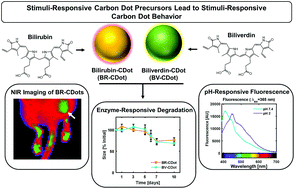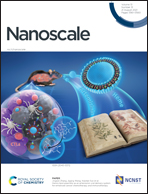Near-infrared emitting dual-stimuli-responsive carbon dots from endogenous bile pigments†
Abstract
Carbon dots are biocompatible nanoparticles suitable for a variety of biomedical applications. Careful selection of carbon dot precursors and surface modification techniques has allowed for the development of carbon dots with strong near-infrared fluorescence emission. However, carbon dots that provide strong fluorescence contrast would prove even more useful if they were also responsive to stimuli. In this work, endogenous bile pigments bilirubin (BR) and biliverdin (BV) were used for the first time to synthesize stimuli-responsive carbon dots (BR-CDots and BV-CDots respectively). The precursor choice lends these carbon dots spectroscopic characteristics that are enzyme-responsive and pH-responsive without the need for surface modifications post-synthesis. Both BV- and BR-CDots are water-dispersible and provide fluorescence contrast, while retaining the stimuli-responsive behaviors intrinsic to their precursors. Nanoparticle Tracking Analysis revealed that the hydrodynamic size of the BR-CDots and BV-CDots decreased with exposure to bilirubin oxidase and biliverdin reductase, respectively, indicating potential enzyme-responsive degradation of the carbon dots. Fluorescence spectroscopic data demonstrate that both BR-CDots and BV-CDots exhibit changes in their fluorescence spectra in response to changes in pH, indicating that these carbon dots have potential applications in pH sensing. In addition, BR-CDots are biocompatible and provide near-infrared fluorescence emission when excited with light at wavelengths of 600 nm or higher. This work demonstrates the use of rationally selected carbon sources for obtaining near-infrared fluorescence and stimuli-responsive behavior in carbon dots that also provide strong fluorescence contrast.



 Please wait while we load your content...
Please wait while we load your content...